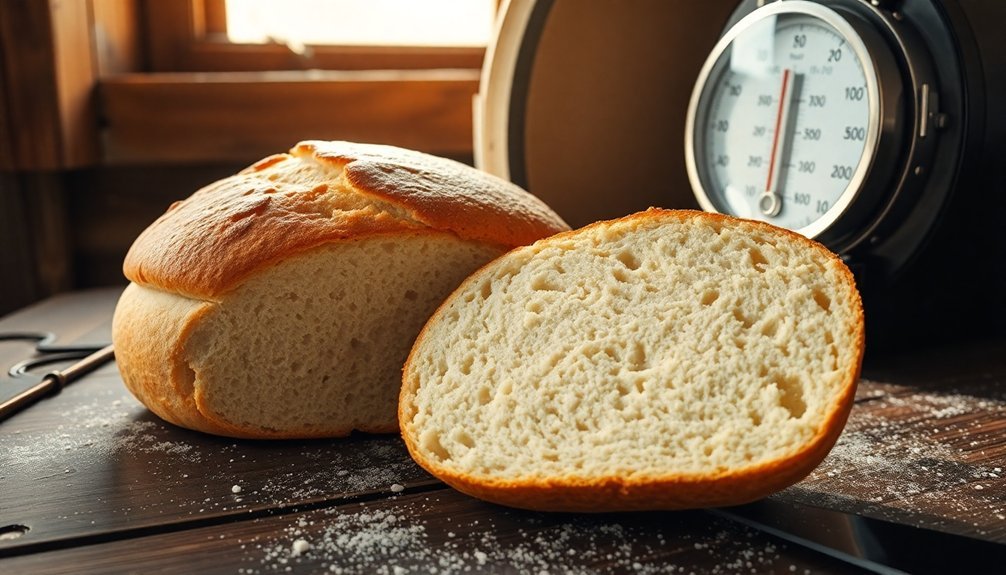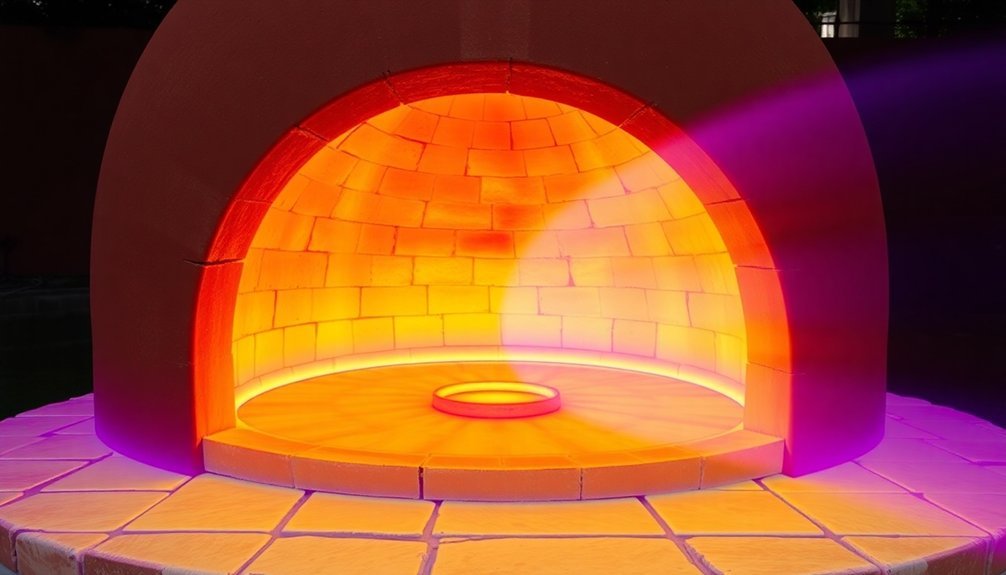Your solar-baked bread isn't rising due to several common issues with temperature and yeast management. If your oven temperature isn't consistently between 325-350°F, or if you're not adjusting the reflector panels every 30-45 minutes to maintain 82-83°F during rising, your dough won't develop properly. Your yeast might be inactive or killed by temperatures above 90°F, while temperatures below 70°F will slow fermentation too much. Poor humidity control and incorrect ingredient ratios, especially in salt (1.5-2.25%) and sugar (8-15%), can also prevent proper rising. Understanding these factors will help you master the art of solar bread baking.
Temperature Control in Solar Ovens

Temperature control in solar ovens presents one of the biggest challenges for baking bread. When you're trying to achieve the ideal 325-350°F range needed for proper bread rising, cloud cover and temperature fluctuations can quickly derail your baking efforts.
You'll find that these inconsistencies often lead to uneven rising or complete failure of your bread to rise at all.
To improve your chances of success, you'll need to start by selecting the right type of solar oven. Box cookers typically offer better heat retention than panel or parabolic designs, making them more suitable for bread baking. With temperatures reaching up to 392°F, box cookers provide the consistent heat needed for proper bread rising.
It's vital to use a reliable thermometer to monitor the temperature throughout the baking process. You'll also want to properly preheat your oven before adding the dough, which helps establish a more stable cooking environment.
Correct positioning is significant – you'll need to align your solar oven to maximize sun exposure and maintain consistent temperatures.
Don't forget to adjust the reflective panels as needed to direct sunlight efficiently. If your oven has insulation issues, you might notice temperature drops that prevent proper rising, so make certain it's well-sealed and properly insulated.
Yeast Quality and Storage
Success in solar bread baking heavily depends on the quality and proper storage of your yeast. If you're using expired or improperly stored yeast, your bread won't rise properly, regardless of your solar oven's performance. Excess salt can prevent proper yeast activation and rising in your solar-baked bread.
| Storage Tips | Proofing Guidelines |
|---|---|
| Keep yeast in airtight containers | Use water at 105-115°F |
| Store in cool, dry places | Add a pinch of sugar |
| Refrigerate or freeze for longevity | Wait 5-10 minutes for foam |
| Check expiration dates regularly | Look for bubble formation |
| Avoid heat and sunlight exposure | Discard if no activity |
Before using yeast in your solar bread recipe, you'll need to verify it's still active through proofing. Mix your yeast with warm water and a small amount of sugar – if it doesn't foam and bubble within 10 minutes, you'll need fresh yeast. Choose the right type for your recipe, as different yeasts serve different purposes. For instance, if you're making sweet dough, you'll want osmotolerant yeast that can handle high sugar content. Remember that even the best solar oven setup won't compensate for inactive yeast, so proper storage and handling are essential for successful solar baking.
Solar Oven Humidity Management

Managing moisture in your solar oven is essential for successful bread baking, as you'll need to strike a delicate balance between retaining enough humidity for proper dough development and preventing excess condensation.
You can control moisture levels by venting the oven slightly with a small stick or loose latch, which lets steam escape without losing too much heat.
While some moisture retention helps your bread's texture, too much condensation on the glass lid will block sunlight and reduce the temperature needed for proper rising. Consider using metal binder clips to secure the lid while maintaining proper ventilation.
Moisture Retention Techniques
Proper moisture control stands at the heart of successful solar oven baking. You'll need to balance moisture retention and release to achieve the best results when baking bread in your solar oven. Using baking dishes with lids helps trap essential heat while giving you control over moisture levels during the baking process.
You can manage excess moisture through several effective techniques. If you notice condensation covering your oven's glass, quickly open the lid for 2-3 seconds to release steam. For more controlled moisture release, try propping the oven door open by half an inch or leaving the latches slightly loose.
While these methods will cause some heat loss, they're vital for preventing excessive moisture buildup that can hamper your bread's rise.
Don't forget to take into account your cookware choices and weather conditions. You'll want to use covered baking dishes that help retain heat while allowing you to regulate moisture.
Check the weather forecast before starting – partly cloudy skies can create inconsistent temperatures and moisture issues.
Remember to thoroughly dry your solar oven's interior after use to prevent mold and rust, ensuring it's ready for your next baking session.
Temperature-Humidity Balance Control
The delicate interplay between temperature and humidity greatly impacts your bread's ability to rise in a solar oven. You'll need to maintain a consistent temperature of around 325°F while managing moisture levels to achieve ideal results.
When humidity levels are too high, they can create an insulation layer that affects your bread's texture and rise, while too little moisture can lead to a dry, tough crust that restricts expansion.
To master temperature-humidity control in your solar oven:
- Monitor your oven's ventilation by leaving latches slightly loose or using a small stick to create a gap, allowing excess steam to escape while minimizing heat loss.
- Adjust reflective flaps throughout the baking process to maintain steady temperatures, especially during partly cloudy conditions.
- Check weather forecasts beforehand to guarantee clear skies, as cloud cover can disrupt the continuous heating needed for proper rising.
Remember that external factors like ambient temperature and seasonal changes will affect your oven's internal conditions.
If you're baking in mountainous or tropical regions, you'll need to be particularly mindful of how local weather patterns influence both temperature and humidity levels inside your solar oven.
Proper Dough Preparation
Getting your dough to rise in a solar oven starts with precise measurements of flour and liquid to achieve the right consistency for proper fermentation.
You'll need to monitor your dough temperature closely, aiming for 82-83°F, as solar ovens can create unpredictable temperature fluctuations that affect yeast activity.
Your careful attention to these fundamentals will help guarantee your dough has the best chance of rising, even in the variable conditions of solar baking.
Correct Flour-to-Liquid Ratio
Mastering flour-to-liquid ratios stands as the cornerstone of successful bread making, whether you're using solar or conventional methods. For basic bread recipes, you'll want to maintain a 5:3 flour-to-water ratio, though this can vary based on your flour type. When using 15 ounces of flour, you'll need approximately 9 ounces of water to achieve the right consistency.
Different flours demand different hydration levels, which directly affects your bread's rise. Bread flour typically requires more water than all-purpose flour, while whole grain flour has its own unique absorption rate. You'll know you've hit the sweet spot when your dough feels tacky but doesn't stick to your hands.
- Aim for 60-70% hydration for most bread recipes
- Add 1 teaspoon of yeast per pound of flour
- Include 0.3 ounces of salt per 15 ounces of flour
To create the perfect mix, start by adding your flour first, then place salt and yeast on opposite sides of your bowl. Add water gradually while mixing, and knead for 5-10 minutes until your dough becomes smooth and elastic.
This methodical approach guarantees proper gluten development and ideal rise potential.
Proper Temperature Control
Beyond precise ratios, proper temperature control shapes your dough's success from the moment you mix ingredients. When using a solar oven, you'll need to carefully manage temperatures throughout the entire process, starting with your initial ingredients.
Your liquids should be at room temperature when you combine them with the yeast, as cold liquids can shock and inhibit yeast activity while hot liquids may kill it entirely. For ideal yeast activation, maintain temperatures between 75°F and 85°F during the mixing phase. If your kitchen is cold, you'll need to create a warmer environment using a proofing box or finding a draft-free spot.
In a solar oven setup, you'll face unique temperature challenges. Since solar ovens rely on sunlight, you'll need to regularly adjust the oven's position to maintain consistent temperatures.
Watch for fluctuations that can affect your bread's rise – temperatures above 90°F will kill your yeast, while anything below 70°F will greatly slow down fermentation. Keep rotating your oven's turntable to maximize sun exposure, and be prepared to adjust your baking time based on temperature variations throughout the day.
Timing Your Solar Bake

The timing of your solar bread bake requires careful attention to several factors that don't affect conventional baking. Unlike predictable conventional ovens, solar ovens maintain lower temperatures around 325-350°F, which greatly extends your baking time. Cloud cover and weather fluctuations can further complicate the process, making timing more critical than ever.
Key timing considerations you need to monitor:
- Don't proof your dough beyond three-quarters of the pan height, as the slower temperature adjustments in solar ovens can lead to over-proofing.
- Expect your baking time to stretch several hours longer than conventional methods, regardless of whether you're making quick or yeast breads.
- Plan to rotate your loaf periodically for even baking results.
You'll need to let your dough rise in a warm environment until it doubles in bulk, but temperature control is trickier with solar baking. Using a proofing box can help maintain the ideal 82-83°F rising temperature.
To guarantee your bread is fully baked, check that the internal temperature reaches 200°F, as visual cues alone aren't as reliable in solar baking.
Equipment and Setup Essentials
Your solar-baked bread won't rise properly unless you've positioned your reflector panels at the ideal angle to maintain consistent temperatures between 82-83°F (28-28.5°C) for the initial rise and up to 200°F (93°C) for baking.
You'll need to check your oven's internal temperature regularly with a thermometer and adjust the panels throughout the day to follow the sun's movement.
For even heat distribution, place your dough in a dark-colored, well-insulated container and line the oven's interior with black construction paper, which helps absorb and distribute heat uniformly.
Solar Oven Temperature Control
Maintaining consistent temperatures in solar ovens requires careful attention to equipment selection and setup procedures. To achieve the ideal bread-baking temperature range of 150-225°F, you'll need to implement proper monitoring and adjustment strategies. A reliable thermometer is essential for tracking your oven's temperature fluctuations throughout the baking process.
- Position your oven directly facing the sun and adjust its alignment every 30-45 minutes to maintain peak heat collection.
- Use multiple layers of insulation around the cooking cavity, confirming your glazing material is securely sealed to prevent heat loss.
- Preheat your solar oven for at least 30 minutes before adding your bread dough.
Your success in maintaining steady temperatures depends heavily on weather conditions and proper positioning. Dark, thin metal cookware with tight-fitting lids will help maximize heat absorption while minimizing loss.
If you're baking on partly cloudy days, implement heat retention strategies by storing energy during sunny periods. Consider using real-time tracking tools like photoresistors and servo motors for more precise temperature control.
Remember to monitor and adjust your oven's position periodically to confirm it remains in direct sunlight and maintains the peak temperature for bread rising.
Reflector Panel Positioning
Proper positioning of reflector panels builds upon effective temperature control by maximizing the sun's energy capture. Your reflector's angle shouldn't exceed 22.5 degrees from perpendicular to the glass, with taller reflectors performing best at 20 degrees. For consistent heat distribution, you'll need to position your reflector so sunlight from its upper edge reaches the far side of the glazing.
| Reflector Element | Key Requirement |
|---|---|
| Angle Range | 110-112.5 degrees for tall panels |
| Material Options | Aluminum foil, reflective insulation, mirrors |
| Mounting | Secure attachment in adjustable carcase |
| Sun Tracking | Regular repositioning from 11 AM – 3 PM |
| Heat Direction | 45-degree angle to target pot sides |
You'll need to adjust your reflector throughout the day to follow the sun's path. Mount your reflective material securely in a frame that allows for easy angle adjustments. Whether you're using aluminum foil, reflective insulation, or mirrors, make sure they're properly oriented to direct heat onto your cooking vessel's black surface. A clear cover over your cooking area will trap the reflected heat while letting sunlight pass through.
Container Heat Distribution
An effective solar bread box relies on precise heat distribution through multiple complementary components. Your container's ability to maintain consistent temperatures between 75-78 degrees depends on proper insulation and strategic material placement. The combination of an inner and outer box creates an essential insulation gap, while foam board lining and weather stripping around the edges prevent unwanted heat loss.
- You'll need to guarantee your transparent cover fits tightly to trap the greenhouse effect while allowing sunlight to reach the black base tray, which conducts heat directly to your bread pan.
- Your insulation materials (feathers, cotton, or newspapers) must be packed evenly between the container walls to eliminate cold spots that could affect bread rising.
- The container's placement matters – position it away from wind and temperature fluctuations that could disrupt the stable internal environment.
Your box's heat distribution system works through multiple heat transfer methods: radiation through the glass cover, conduction from the black base, and trapped convection heat.
Any gaps or cracks in the container will compromise this delicate balance, leading to uneven heating and poor bread rising results.
Weather Impact on Bread Rise

Through varying weather conditions, your bread's rise can fluctuate dramatically. Temperature plays an essential role, as yeast becomes more active in warmer conditions between 25°C to 35°C (77°F to 95°F). When it's too hot, above 35°C (95°F), you'll kill the yeast, while temperatures below 0°C (32°F) will greatly slow down fermentation.
Humidity levels affect your dough's behavior too. In high humidity, your flour will absorb extra moisture, making high-hydration doughs particularly challenging to handle. You'll need to adjust your water-to-flour ratio accordingly, often reducing the liquid content to maintain proper consistency.
To adapt to warm weather, you can reduce your yeast by 10-20% and use cooler water to control fermentation. Keep your dough at or below 75°F (24°C) to prevent over-proofing.
In cold conditions, do the opposite: increase your yeast amount and use tepid water. You'll also want to create a warmer environment for rising, such as using an oven with just the light on.
Remember that cold-weather bread will need more time to rise, but this extended fermentation can enhance flavor development.
Gluten Development for Solar Baking
Beyond weather conditions, successful solar bread baking hinges on understanding gluten development. Your bread's rise depends on a strong gluten network that traps gases and maintains structure. When you're baking with solar energy, you'll need to pay extra attention to gluten formation since lower temperatures can affect how your dough performs.
- You'll want to choose high-protein bread flour (12-14%) for solar baking, as it creates a stronger gluten network that's more likely to withstand slower temperature increases.
- Don't rush the kneading process – you'll need proper alignment of glutenin proteins and formation of disulfide bonds to create a robust structure.
- Be cautious with fats in your recipe, as they'll coat flour particles and prevent proper gluten development – consider reducing fat content slightly for solar baking.
The challenge with solar baking lies in achieving and maintaining adequate temperatures. Since most solar ovens struggle to reach the ideal 375°F needed for peak gluten network function, you'll need to compensate with stronger gluten development during preparation.
This means more attention to proper mixing techniques and careful ingredient selection to guarantee your bread can rise despite lower baking temperatures.
Sugar and Salt Balance

When it comes to solar bread baking, maintaining the right balance between salt and sugar can make or break your loaf's rise. Salt controls fermentation by slowing down yeast activity, while sugar provides the fuel yeast needs to produce carbon dioxide.
You'll want to keep your salt levels between 1.5% and 2.25% of your flour weight to guarantee proper gluten development and controlled fermentation.
If you're using white bread recipes, you'll typically need between 0-15% sugar, with 8% being a common target. Adding too much sugar (over 15%) will cause rapid fermentation, which can make your dough rise too quickly and potentially collapse.
Conversely, too much salt will slow fermentation to a crawl, preventing proper rise.
Watch for signs of imbalance in your dough. If it's rising unevenly or can't hold its shape, you might've too little salt weakening the gluten structure.
If it's barely rising at all, excess salt could be the culprit. A sticky, rapidly rising dough often indicates too much sugar without enough salt to regulate the fermentation process.
Solar Box Ventilation Tips
Proper ventilation in your solar box oven can make the difference between a beautifully risen loaf and a dense, disappointing result. When moisture gets trapped inside your solar oven, it creates a humid environment that can interfere with the bread's rising process. You'll need to strike the right balance between heat retention and airflow to achieve ideal results.
- Position your solar oven in an unshaded area and install an adjustable flap or lid that lets you control both sunlight exposure and ventilation. You can modify this throughout the baking process as needed.
- Create strategic airflow channels around your oven while ensuring all heat-retaining seams are properly sealed. This will prevent excessive moisture buildup while maintaining stable temperatures between 70°F and 90°F.
- Monitor your oven's internal conditions regularly with a thermometer, and adjust the ventilation flaps accordingly. If you notice condensation forming on the plastic wrap window, it's a sign you need more airflow.
Remember to regularly reposition your oven to follow the sun's movement, ensuring consistent heat distribution while maintaining proper ventilation.
Keep reflective surfaces angled correctly to maximize sunlight absorption without compromising airflow.
Frequently Asked Questions
Can I Use Sourdough Starter Instead of Commercial Yeast in Solar Baking?
Yes, you can use sourdough starter in solar baking instead of commercial yeast. You'll need to allow longer proofing times and maintain consistent temperatures. It's important that your starter's active and healthy.
Does Altitude Affect Bread Rise Differently in Solar Ovens?
Yes, your bread's rise in a solar oven at altitude requires extra attention. You'll need to reduce yeast even more than usual since both high altitude and solar baking's variable temperatures can accelerate rising.
How Do Different Bread Pan Materials Impact Rising in Solar Ovens?
In your solar oven, ceramic or insulated pans will give you the best rise since they'll retain both heat and moisture consistently. Glass pans work well too, while metal and non-stick pans may hinder proper rising.
Should I Adjust Ingredient Proportions When Baking Bread in Solar Ovens?
You'll want to increase yeast slightly (25% more) and reduce water by 10% when baking in solar ovens. Keep other ingredients the same, but guarantee you're using bread flour for better structure and rise.
Can I Use Bread Improvers to Enhance Rise in Solar-Baked Bread?
You can use bread improvers in solar-baked bread, but they're not a magic solution. Instead, focus on proper yeast activation, temperature control, and dough handling for better results in your solar baking.
In Summary
If you're still struggling with flat solar-baked bread, check your temperature control, yeast freshness, and humidity levels first. Don't forget to knead thoroughly for proper gluten development and monitor your dough's timing in the solar oven. You'll need to adjust your recipe's moisture content and baking time based on weather conditions. With practice and attention to these factors, you'll achieve well-risen solar bread.





Leave a Reply